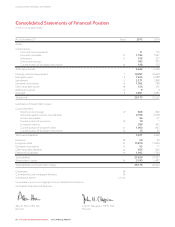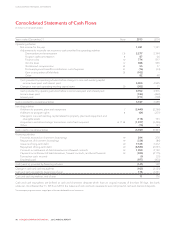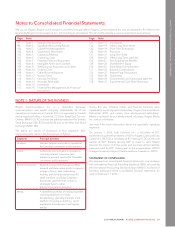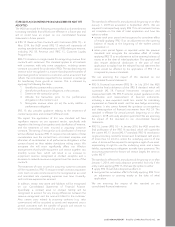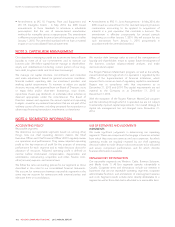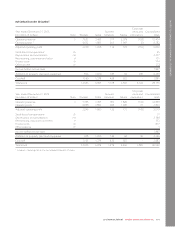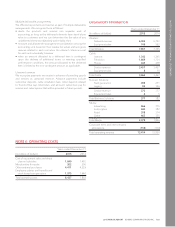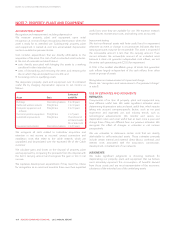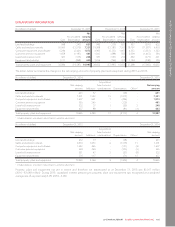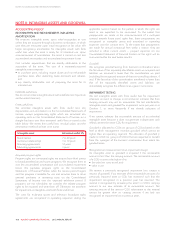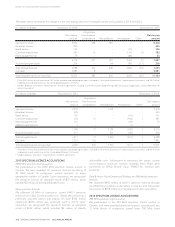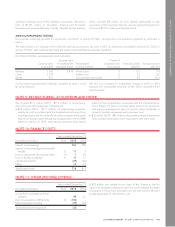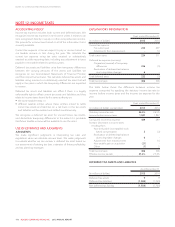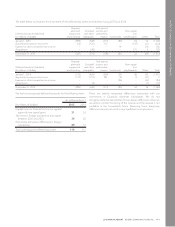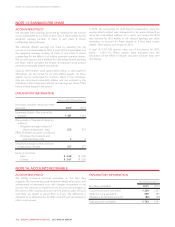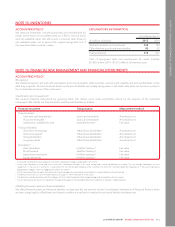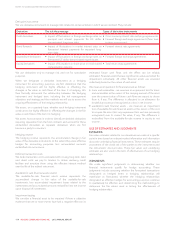Rogers 2015 Annual Report Download - page 106
Download and view the complete annual report
Please find page 106 of the 2015 Rogers annual report below. You can navigate through the pages in the report by either clicking on the pages listed below, or by using the keyword search tool below to find specific information within the annual report.
NOTES TO CONSOLIDATED FINANCIAL STATEMENTS
NOTE 7: PROPERTY, PLANT AND EQUIPMENT
ACCOUNTING POLICY
Recognition and measurement, including depreciation
We measure property, plant and equipment upon initial
recognition at cost and begin recognizing depreciation when the
asset is ready for its intended use. Subsequently, property, plant
and equipment is carried at cost less accumulated depreciation
and accumulated impairment losses.
Cost includes expenditures that are directly attributable to the
acquisition of the asset. The cost of self-constructed assets includes:
• the cost of materials and direct labour;
• costs directly associated with bringing the assets to a working
condition for their intended use;
• costs of dismantling and removing the items and restoring the
site on which they are located (see note 20); and
• borrowing costs on qualifying assets.
We depreciate property, plant and equipment over its estimated
useful life by charging depreciation expense to net income as
follows:
Asset Basis
Estimated
useful life
Buildings Diminishing balance 5 to 40 years
Cable and wireless network Straight-line 3 to 30 years
Computer equipment and
software
Straight-line 4 to 10 years
Customer premise equipment Straight-line 3 to 5 years
Leasehold improvements Straight-line Over shorter of
estimated useful
life or lease term
Equipment and vehicles Diminishing balance 3 to 20 years
We recognize all costs related to subscriber acquisition and
retention in net income as incurred, except connection and
installation costs that relate to the cable network, which are
capitalized and depreciated over the expected life of the Cable
customer.
We calculate gains and losses on the disposal of property, plant
and equipment by comparing the proceeds from the disposal with
the item’s carrying amount and recognize the gain or loss in net
income.
We capitalize development expenditures if they meet the criteria
for recognition as an asset and amortize them over their expected
useful lives once they are available for use. We expense research
expenditures, maintenance costs, and training costs as incurred.
Impairment testing
We test non-financial assets with finite useful lives for impairment
whenever an event or change in circumstances indicates that their
carrying amounts may not be recoverable. The asset is impaired if
the recoverable amount is less than the carrying amount. If we
cannot estimate the recoverable amount of an individual asset
because it does not generate independent cash inflows, we test
the entire cash generating unit (CGU) for impairment.
A CGU is the smallest identifiable group of assets that generates
cash inflows largely independent of the cash inflows from other
assets or groups of assets.
Recognition and measurement of impairment charge
Please see “recognition and measurement of impairment charge”
in note 8.
USE OF ESTIMATES AND JUDGMENTS
ESTIMATES
Components of an item of property, plant and equipment may
have different useful lives. We make significant estimates when
determining depreciation rates and asset useful lives, which require
taking into account company-specific factors, such as our past
experience and expected use, and industry trends, such as
technological advancements. We monitor and review our
depreciation rates and asset useful lives at least once a year and
change them if they are different from our previous estimates. We
recognize the effect of changes in estimates in net income
prospectively.
We use estimates to determine certain costs that are directly
attributable to self-constructed assets. These estimates primarily
include certain internal and external direct labour, overhead, and
interest costs associated with the acquisition, construction,
development, or betterment of our networks.
JUDGMENTS
We make significant judgments in choosing methods for
depreciating our property, plant and equipment that we believe
most accurately represent the consumption of benefits derived
from those assets and are most representative of the economic
substance of the intended use of the underlying assets.
104 ROGERS COMMUNICATIONS INC. 2015 ANNUAL REPORT


